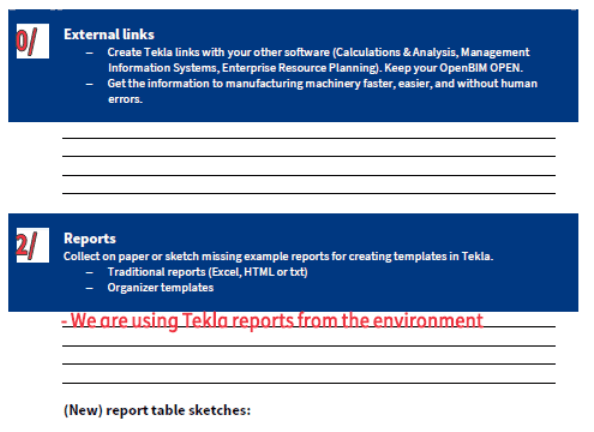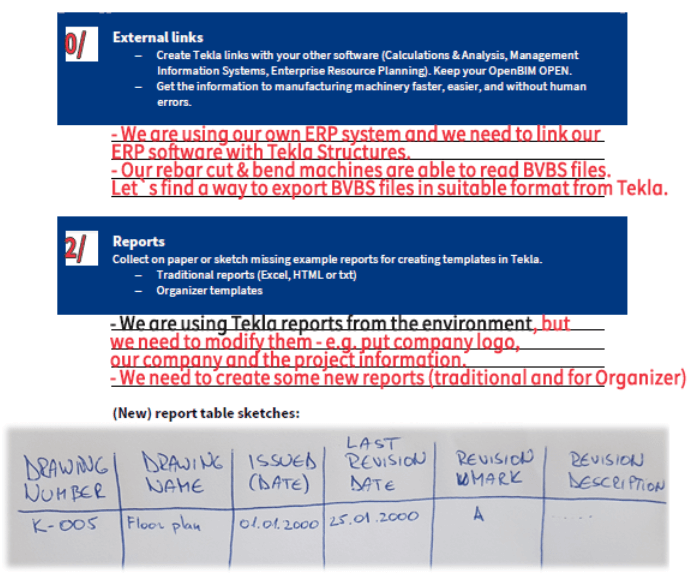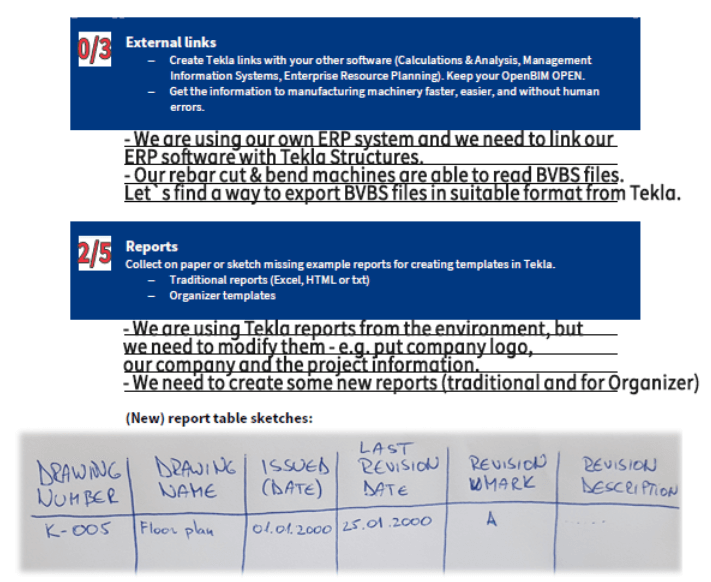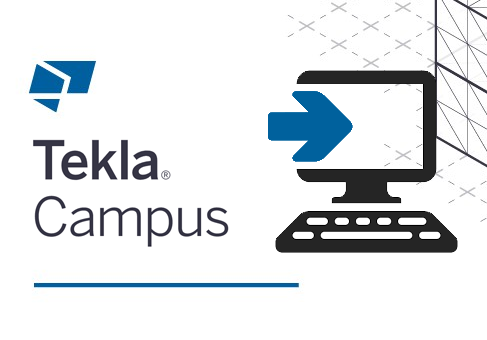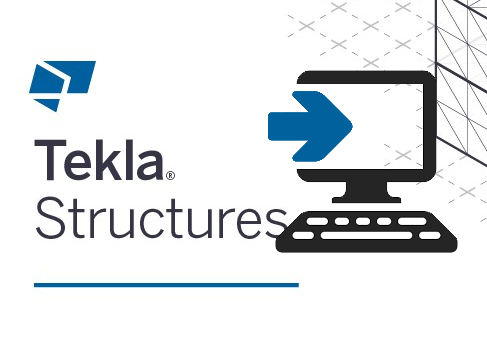We’ve helped produce one Tekla official environment, and since 2017, more than 10 company level localizations.
From producing these localizations, we’ve helped companies get started from scratch and quickly get the output the market is demanding from them. Later, seeing the value, we have brought up their Tekla efficiency to the next level.
Over years doing this work again and again, we have noticed a pattern and we have developed our extensive (more than 20 pages long) “Tekla Implementation Checklist” that we’ve used both for doing an audit or implementation plan with:
- new companies starting out with Tekla Structures in their organization, and want to get going as quickly as possible, and,
- companies already using Tekla Structures that want to find ways to improve their system and make it more efficient.
Now we’ve decided to make this checklist public and share it with you for free. Use this checklist to evaluate your company’s Tekla situation and we’re sure you’ll get some new ideas on how to improve the system and get Tekla working better for you.
Keep reading about our three step implementation process that has evolved with years of experience, and how to use this checklist on the way.
CONTENTS
WHY IS LOCALIZATION IMPORTANT?
Tekla Structures is not the cheapest software on the market, and for most new users, it may be a little difficult to see a good return on investment.
Often they say that the price is higher than other systems and it still takes the same amount of time – or even more – to get the same project done. But other companies who have used Tekla Structures for some time realize the benefits and laugh at the thought of going back to CAD software!
So why do some companies get more value from Tekla than others?
I believe that the difference is because of two main factors:
- People – what people are used to working with, how they feel about it and how good they are with the software. Some people adopt new ways of working faster than others, but if there is a combination of motivation to use Tekla and good training with lots of practice, they will become effective.
- Software – Tekla is a very powerful tool that has many possibilities, but out of the box it doesn’t do everything for you automatically. Ultimately, Tekla needs to be configured and tailored to your company’s needs. It’s your job to tell Tekla how you want things done. You need to customize and automate it according to your needs, in order to let it automatically do as many tasks as possible for you.
At Tekla HQ in Finland they have developed this fantastic tool and offices all over the world have done ~30 environments to customize it for local area needs.
Still, every company has its own specific needs, and in order to get most from it, localization at the company level is heavily recommended – or in some cases even inevitable.
The good thing is that you do the implementation only once, and all your future jobs will be affected positively without any extra effort. Tekla automation will help engineers be more productive and at the same time, the project quality will increase through the reduction of mistakes.
STEP 1. MAP THE SITUATION
The first thing that needs to be done is to map the current situation.
With a new Tekla user, this task is easier, as they are starting with a clean slate.
With an existing Tekla user, a full audit needs to be performed by following all the steps outlined in this document. It’s necessary to have a good overview of what has been done already to see what is missing, and at the same time, we want to reuse all the work that has been already done as much as possible.
Aside from investigating the Tekla-specific system setup, it’s very useful to get an overview of the company and its clients at least at some level. It’s also useful for the next steps – offering improvement options, prioritizing them, and finally combining them to into one structured and prioritized development plan. Depending heavily on the company type and specifics, the process usually looks like this:
- We go through the current workflow from beginning to end. We don’t consider ourselves to be business consultants, but in many cases we can provide some good ideas that we have seen working well in other companies on how to get more benefits from the software for the whole workflow. There may even be changes we recommend at a higher level in order to obtain maximum benefits to your company as a whole, and subsequently for your clients.
- Looking at the areas that you see the most problems in, and where you are looking for efficiency improvements. These two points should be always be kept in mind, in order to improve the company. How can we improve our efficiency and minimize project mistakes?
Finding the things of extra value that you can offer to your clients which your competitors don’t provide. We can’t always raise the prices for our work, but by offering this extra value, we will stand out from our competitors. The aim is to get a better reputation and get more work offers without lowering prices.
In your checklist…
Write a number between 0-5 to rate your current situation and add comments below, like this:
STEP 2. IMPROVEMENT POSSIBILITIES
After mapping the current situation, it’s time to brainstorm or map all the improvement possibilities.
The base idea or usage of Tekla Structures is the same everywhere, but given that it’s such a capable and customizable software, it can be interesting to see how different companies are inventing different ways of getting more benefits from the same system.
If you already have this top-notch tool, using it to its full potential will ensure it’s as useful and profitable an investment as possible.
In your checklist…
Write all the ideas you can think of to improve; something like this:
STEP 3. PRIORITIZING
The last step before implementing changes and improvements is to prioritize the tasks.
The crucial tasks should be addressed first, followed by the tasks that provide the most value or benefits with the least time/money investment.
Our main goal is to ensure you will get more value and maximum return on your investment.
Each company case will be different, but often the priority order at a high level will look something like this:
- Getting Tekla Structures and licenses working on the company system and on everyone’s computer.
- Set common modelling rules and the most important guidelines.
- Essentials to fulfill basic market needs and get at least the same output as you got before with AutoCAD. This includes drawing and report templates with printing and exporting to DWG or PDF.
- The extra value that you can provide to your clients, without extra effort – e.g. OpenBIM IFC model or some other export formats, or additional information (Excel table/paper, or even in a visual way).
- Automate drawing creation: the drawing style, marks, and shop drawing dimensions. Usually, we start with general arrangement drawings and continue with shop drawings. The aim is to get drawings as fast as possible and minimize human errors. Some degree of human intervention is always needed, but utilizing the speed and ability of the computer to do the work according to the rules is a great productivity gain.
- Automated modelling: create pre-saved settings for existing tools or develop new custom components/macros/OpenAPI development tools to get more things done automatically and faster, with fewer errors. With different tools and settings, we can also speed up the modelling component and minimize possible errors or inconsistencies in the model.
- Documentation, e.g. rules, checklists, instructions, and examples. Document and standardize the processes to ensure that all projects will be done in the same manner. This is how every teenager working at McDonald’s restaurants can produce burgers with exactly the same taste and quality anywhere in the world.
- Training materials and video tutorials, especially for new employees. Once you have a successful system, very soon you need more and more skilled employees.
In your checklist…
You can prioritize each topic, or even better, add priorities to each idea in this topic (if you have there more than one). Something like this:
BONUS – RECOMMENDATIONS
In the planning stage, we highly recommend including people with experience in setting up Tekla environments, and anyone with knowledge on best practices or possible mistakes made by other companies. It’s far more efficient to include these people in the planning stage in order to avoid additional work down the line.
Spending a little more time on planning and getting it right the first time saves you a lot of time and money later. This principle is demonstrated well in construction, where spending more time on decisions at the beginning are much cheaper than having to make remedial changes later. Remember – measure twice, cut once!
Doing the situation audit and plan is only the first step. Without any action, it will remain on paper as a cute plan without any practical value. Use the momentum that you have right now and start with the first small steps as soon as possible. Based on priorities divide your plan into smaller phases that is easier to start and complete. If you don’t do it right away, the probability will rise that you will not do it in the future either. Every month that you don’t use Tekla to its full potential means your engineers and detailers are also inefficient and not as profitable.
We understand your situation and want to help. That’s why we provide this most important checklist without cost. Use it wisely, and if you have any questions, feel free to contact us contact@tsguide.eu – we’re more than happy to assist!
If there are no highly skilled Tekla ninjas in your company or they are quite busy with ongoing projects then go and check out how we could help you – https://www.tsguide.eu/tekla-company-environment/
Go also read our previous article Free Tekla education “Getting started” step by step guide.
AUTHOR

Tekla Structures grandmaster and TSGuide OÜ founder.


